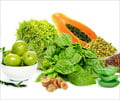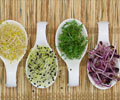- The ISS (International Speciality Supply, USA): a company that supplies sprouts throughout the world.
About
Consuming sprouts is like eating live vegetable food. Think for yourself, how nutrient-dense a growing food could be…
It is said that sprouts ‘represent the miracle of birth’. They are in the true sense, super foods. They are alkaline, whole, pure, and natural foods. It is inexcusable that though aware of their miraculous effects, we do not take full advantage of them. We scour departmental and organic stores, looking for health foods and recipes, but forget to eat ordinary sprouts on daily basis – considering them a poor cousin of high-fashion health foods.

Sprouts are the cheapest and most convenient source of complete nourishment. They are food for long-term health and wellness. If consumed judiciously and chosen over other foods, they can prevent diseases and lifestyle-related ailments. Sprouting a seed enables it to produce an enormously enhanced bundle of nutrients.
A sprout is at the transitional stage between seed and plant. It is, to put it simply, a baby plant. These are essentially pre-digested foods as the seeds’ own enzymes do most of the work. The nutritional changes that occur during sprouting primarily happen because complex compounds get broken down into simpler forms. This, added to development of some essential nutrients, constituents, and breakdown of anti-nutrients, makes the whole phenomenon of sprouting possible. Metabolic activity in dormant seeds is initiated as soon as they are hydrated during soaking.
Sprouted seeds acquire natural increased digestibility and nutrients as compared to unsprouted seeds. They provide us with all the essential minerals and vitamins, and must ideally form a part of our daily diets.
The sprouting process:
On sprouting, grains, legumes, and seeds turn into super foods. They then become an extremely sound source of protein, fiber, and vitamin B.
All edible grains, legumes, and seeds can be sprouted. The following are generally used for sprouting:
- Grains: Wheat (wheat grass is the sprouted form of wheat. It must be juiced. Soak hard wheat grains for 12 hours and then grow in soil. It will be ready in 12 days’ time), maize, ragi, barley, bajra.
- Seeds: Alfalfa seeds (sensitive to heat, ready in seven days), sesame seeds, radish seeds, fenugreek seeds (bitter in taste. To be mixed with milder sprouts to tone it down, ready in 9 days’ time), coriander seeds, pumpkin seeds, and musk melon seeds, groundnut.
- Legumes: Green gram, Bengal gram, chickpea, kidney beans, dried peas.
- Oats: (oat groats) to be used -- ready in 3 to 4 days), buckwheat, quinoas are foods which are lesser known as sprouts, but are at the same time, highly nutritious. They should be sprouted and consumed if readily available.
Alfalfa is called the ‘father of all foods’ or the ‘king of sprouts’. It is highly rich in minerals like manganese and is also a rich source of vitamins A, B, C, E, and K. It also contains all the essential amino acids. Alfalfa contains most of the essential amino acids and has a higher concentration of calcium than milk. The lesser explored sesame seed sprouts are also said to be great source nutrients. They too, contain most of the essential amino acids and are high in vitamin E and vitamin B complex, apart from other nutrients.
The sprouting process
Firstly, one has to ensure that the seeds, legumes or grains will easily sprout. (For instance, soyabeans are said to become sour and do not sprout too well; and wheat has to be grown in soil). The seeds should be thoroughly washed and then soaked in fresh water overnight. The time span of soaking is mostly 12 hours, though it depends on the size of the seeds. Next morning the seeds should be rinsed and the water drained off. Soaking turns the seed soft and laden with water. They eventually germinate and become sprouts in two to three days’ time, depending upon the temperature and humidity. One should not soak the seeds for a longer period than required, as the seeds may rot and ferment. After they sprout, they should be stored in a refrigerator.
Nutritional Benefits:
The ISS (International Speciality Supply, USA) is a company that supplies sprouts to many countries. It describes in detail, the nutrient changes which occur during the process of sprouting. On sprouting, there is a tremendous increase in nutrients as compared to the dried embryo. The vitamins, minerals and protein content substantially increase with a simultaneous decrease in caloric and carbohydrate content. Pulses and seeds show a very low water content. This, however, tends to increase tenfold when converted into sprouts. The ISS elaborates that sprouted green gram (mung beans) have an 8.3 percent increase of water content over dried beans. Hence the nutritional value of sprouted and dried mung beans can be compared by multiplying the analyzed nutrients of sprouted mung beans by the factor of 8.3. Based on this criterion, the changes found in sprouted mung beans when compared with the figures for the beans in the dried state are as follows:
| Energy content - calories | Decrease 15 percent |
| Total carbohydrate content | Decrease 15 percent |
| Protein availability | Increase 30 percent |
| Calcium content | Increase 34 percent |
| Potassium content | Increase 80 percent |
| Sodium content | Increase 690 percent |
| Iron content | Increase 40 percent |
| Phosphorous content | Increase 56 percent |
| Vitamin A content | Increase 285 percent |
| Thiamine or Vitamin B1 content | Increase 208 percent |
| Riboflavin or Vitamin B2 content | Increase 515 percent |
| Niacin or Vitamin B3 content | Increase 256 percent |
| Ascorbic acid or Vitamin C content | An infinite increase |
The increase in protein availability is of great significance. It is a valuable indicator of the enhanced nutritional value of a food when sprouted. The amazing fact is that sprouts are a food -- very easily available to all sections of society, and yet the biggest storehouse of all nutrients. The reduction in carbohydrate content indicates molecules being broken down during sprouting to allow absorption of atmospheric nitrogen and re-formation of amino-acids. The resultant protein is the most easily digestible of all proteins available in foods.
Grains, legumes are nowhere even near to be considered a source of vitamin C. However, when sprouted, they reveal significant quantities of this vitamin. The infinite increase in Vitamin C or ascorbic acid derives from their absorption of atmospheric elements during growth.
Sprouts supply food in a pre-digested form -- food, which has already been acted upon by enzymes and simplified. During sprouting, much of the starch is broken down into simple sugars such as glucose and sucrose by the action of the enzyme ‘amylase’. Proteins are converted into amino acids and amides. Fats and oils are converted into simpler fatty acids by the action of the enzyme lipase. Also, during sprouting there is s reduction in the gas producing quality of beans. Mainly oligosaccharides have been held responsible for gas formation. As the process of germination ends and sprouting begins, the content of oligosaccharides is reduced by 90 percent. The content of fiber and water increases tremendously, which is a boon for a healthy digestive system.
Sprouts are a good source of chlorophyll, said to have anti-bacterial and anti-inflammatory properties. They are highly beneficial foods for losing weight too. They keep one full for a long time and also prevent over-eating as one feels satisfied on consuming just a handful.
Sprouts are an extremely inexpensive method of obtaining a concentration of protein, vitamins, minerals and enzymes. Eating sprouts is the safest and best way of getting the advantage of complete nutrition.
Cooking with Sprouts:
Sprouts could be eaten in various ways, other than just the standard salads that we generally know of. They could be used in the following ways:
- To make hummus to be used as dips, for sandwich fillings (sprouted chickpea is best suited for this).
- To make healthy vegetables and curries.
- To be crushed lightly and added to pancakes, or used as a filling for pancakes.
- To prepare a variety of stir fries.
- To cook and serve with rice.
- To be added to yoghurts.
- To be juiced up (wheat grass is a sprout).
- To be dried and turned into malt. This is called malted flour. It is especially given to babies in the form of porridge as it is easily digestible and has a high nutrient density. Ragi malt (Red millet malt) is very commonly prepared in southern India. It’s highly rich in calcium and iron, and is relished by all age groups. The dry ragi sprouts are roasted with wheat, green mung dal, and almonds, and are then ground and cooked with milk and sugar. Malted multigrain flours are also readily available. They can be had as porridge, they can be mixed in flour, or can be added to various food preparations.















